In this article, I will share my method of preparing a Thai-inspired steamed fish recipe, which I modified from the recipe we used in my previous restaurant. This Thai steamed fish recipe is easy to prepare and has a unique flavor quite different from other steamed fish recipes, especially Chinese ones.
The key to this recipe is the sauce, which comprises a blend of saltiness, sweetness, sourness, and spiciness. The good news is that making this dish is relatively straightforward, and no complicated techniques are involved. All you need is to have all the ingredients ready and follow the step-by-step instructions below, and you will make it just like those served in Thai restaurants.
Note: This post may contain affiliate links. Please read my privacy policy for more info. I may receive commissions for purchases made through links in this post. As an Amazon Associate, I earn from qualifying purchases.

1. Get all the ingredients required for steamed fish Ready
Always choose fresh fish for steaming. In Asia, we prefer using the whole fish.
However, you can also use fish fillets if you prefer. In our previous restaurant, we used fish fillets since the setup was cafe-style.
I will use the local siakap (Barramundi fish) for this recipe, but tilapia, snapper, catfish, and other white fish are also common. Since cleaning the fish is tedious, I always recommend asking your fishmonger to remove the guts and gills to save time and effort when cooking the fish.
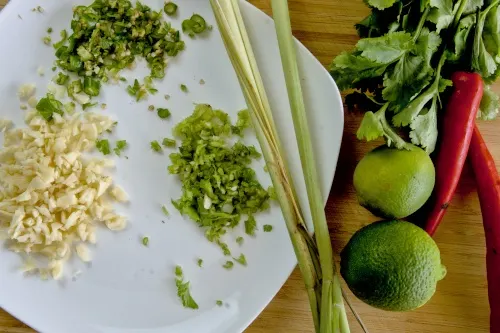
- Stock. I use chicken broth instead of plain water to make the sauce. You can use fish broth if you have, but I have plenty of homemade chicken broth.
- Lime juice. The sourness of the sauce comes from lime. To get the best taste, always use freshly squeezed lime juice and avoid ready-made lime juice sold in the bottle. In Malaysia, we usually use the bigger variety of lime available in the market, as we need quite a fair bit of lime juice. If you don’t have lime, you can use fresh lemon juice as a substitute, although the taste will be slightly different.
- Fish sauce. Fish sauce is the main seasoning ingredient in Thai cuisine, combining anchovies with salt and sugar. It is saltier than Chinese light soy sauce and is sold in most Asian grocery stores and larger supermarkets. It is a staple ingredient in Thai cuisine, like light soy sauce for Chinese cooking. While I used Squid brand fish sauce, you can use any brand available in your area.
- Palm sugar. For this recipe, sugar is necessary to balance the sourness of the lime juice. Palm sugar is preferred due to its unique aromatic flavor, but substitute it with white or brown sugar if unavailable.
- Garlic. Garlic can effectively remove the fishy smell of seafood, making it an excellent choice for steaming fish. I use one head of garlic for a fish weighing around one kg. It may seem like a lot, but it’s just the right amount to create a perfect balance with the other ingredients in the sauce.
- Chilies. The spiciness of the sauce comes from the chilies. We use bird’s eye chilies (cili padi), about two to three inches long. They are quite spicy compared to larger chilies. They come in red and green varieties, with the red ones slightly spicier than the green ones. As I cannot tolerate too much spiciness, I prefer green ones. If you want it to be even less spicy, substitute them with larger red chilies, which are less spicy.
- Coriander. For this steamed fish recipe, the final ingredient is coriander. I am referring to the stems and leaves of coriander, not the seeds. Coriander has two uses in this recipe. Firstly, the stem and the coriander roots are finely chopped and mixed into the sauce for an aromatic smell. Secondly, the fresh coriander leaves are used for garnishing.
Note:
Thailand is a neighboring country of Malaysia, so Thai food is very popular in Malaysia. When we made Thai fish in our cafe, we added some local ingredients besides lime juice to enhance the sourness. We included some tamarind juice (Asam Jawa). Our customers highly appreciated the tamarind’s unique flavor. However, I am not adding it to this recipe, as it might not be available in certain places.
2. Steps to steam the fish
You do not necessarily need to buy a steamer to steam fish. A steamer may not be large enough to hold a big fish.
A stainless steel wok with a lid is the best tool, as it can hold the entire fish. Simply bring some water to a boil in the wok and place a steamer rack or a trivet inside. If you don’t have a steamer rack, place two chopsticks parallel to each other just above the water’s surface to support the plate.
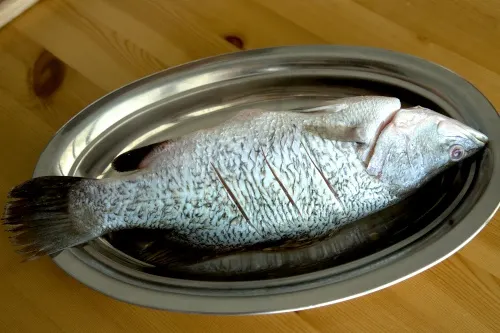
- After cleaning the fish, make three diagonal incisions at the thickest part of the fish on both sides. This step will increase the surface area to let the sauce’s flavor penetrate the flesh.
- This Thai steamed fish recipe is incomplete if you do not infuse the flavor of lemongrass into the fish. Insert the bashed lemongrass into the fish’s cavity before steaming, and only use the white part of the lemongrass to get the best results. However, if you are steaming a fish filet, you won’t be able to insert the lemongrass. In that case, you can finely chop the white part of the lemongrass and mix it into the sauce to maximize the flavor.
- Place a chopstick on the steaming tray, and put the fish on top for the best streaming result. The purpose of placing a chopstick beneath the fish is to provide some space to let the steam pass through the bottom side so that the fish’s top and bottom will be steamed evenly.
- Steam the fish over medium-high heat. The cooking time may vary, but typically, it takes about 8 to 10 minutes to steam a 1 kg fish. The best way to check whether the fish is done is to open the lid and use the chopstick to lift a part of the flesh of the fish. The fish is cooked if it is no longer translucent and the flesh becomes flaky. Overcooking should be avoided as it can toughen the flesh of the fish.
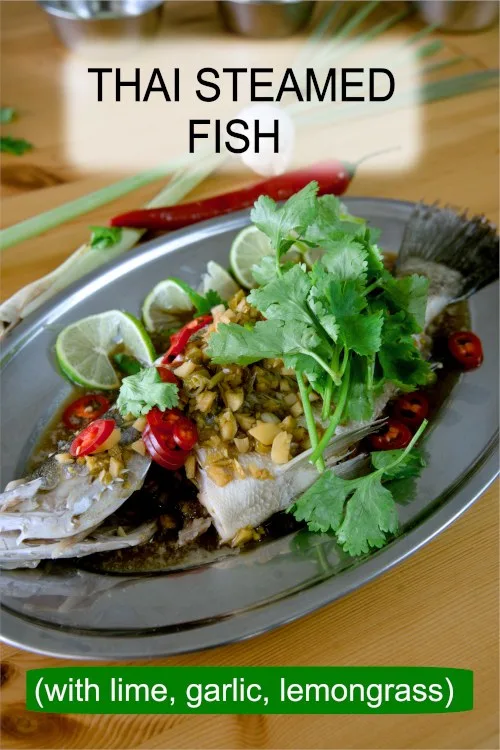
3. Prepare the flavorful Thai-style sauce
The second part of the recipe involves preparing the Thai-style sauce. Here are the steps:
- Bring a small pot of chicken broth to a boil.
- Add sugar to the hot broth and stir until it is fully dissolved.
- Chop garlic, chilies, and coriander stems and add them to the pot. Cook for 15 seconds.
- Finally, add fish sauce and lime juice.
Note: Do not cook the lime juice, which can turn bitter.
4. How to serve Thai steamed fish
- Once the fish is cooked, remove it from the steamer.
- Discard the water from the steaming plate as it has a fishy smell.
- Place coriander leaves on the serving plate and put the fish on top. You can either leave the lemongrass stalks inside the fish cavity or remove them.
- Drizzle the sauce on top of the fish.
- Garnish with coriander leaves, lime twists, and chopped red chilies. You may also add some spring onions to garnish.
- Serve with steamed jasmine rice, which is the best.
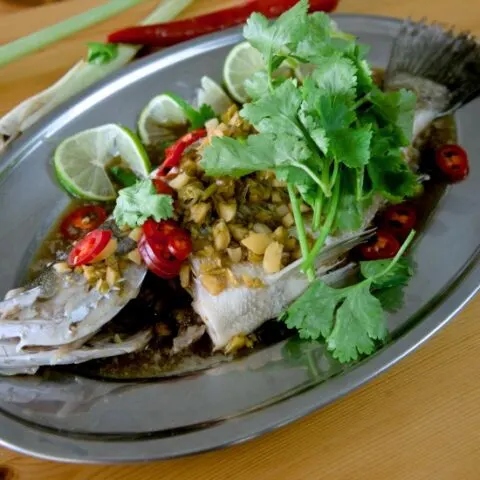
Thai steamed fish with lime, garlic and lemongrass
Thai steamed fish served with a sweet, sour, and spicy sauce. It is an extremely popular Thai food best served with Jasmine rice.
Ingredients
Ingredients A
- 1 whole fish (1kg) with guts and gills removed
- 3 stalks of lemongrass, white parts only, bashed
Ingredients B
- 1/2 cup chicken broth
- 4 tbsp palm sugar
- 1 head of garlic, chopped
- 4 bird’s eye chilies, chopped
- 4 sprigs of coriander (cut the stem for the sauce, leaves to garnish)
- 4 tbsp fish sauce
- 4 tbsp lime juice
- Chopped red chilies, lime slices, and coriander leaves to garnish
Instructions
Steam the fish
- After cleaning the fish, make three diagonal incisions at the thickest part of the fish on both sides.
- Insert the bashed lemongrass into the fish's cavity before steaming, and only use the white part of the lemongrass to get the best results.
- Place a chopstick on the steaming tray and put the fish on top.
- Bring some water to a boil in the wok and place a trivet inside.
- Steam the fish over medium-high heat for 8 to 10 minutes. The fish is cooked if it is no longer translucent and the flesh becomes flaky.
Prepare the flavourful Thai-style sauce
- Bring a small pot of chicken broth to a boil.
- Add sugar to the hot broth and stir until fully dissolved.
- Chop garlic, chilies, and coriander stems and add them to the pot. Cook for 15 seconds.
- Finally, add fish sauce and lime juice.
To serve
- Discard the water from the steaming plate as it has a fishy smell.
- Place coriander leaves on the serving plate and put the fish on top.
- Drizzle the sauce on top of the fish
- Garnish with coriander leaves, lime twists, and chopped red chilies.
Recommended Products
As an Amazon Associate and member of other affiliate programs, I earn from qualifying purchases.
Nutrition Information:
Yield: 2 Serving Size: 1Amount Per Serving: Calories: 324Total Fat: 1gSaturated Fat: 0gTrans Fat: 0gUnsaturated Fat: 1gCholesterol: 1mgSodium: 3081mgCarbohydrates: 79gFiber: 3gSugar: 35gProtein: 8g
This data was provided and calculated by Nutritionix on 12/23/2023

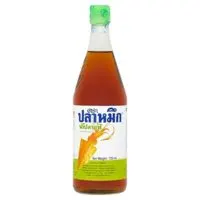



Ginger Scallion Fish- Easy Cantonese fried fish recipe
Saturday 17th of May 2025
[…] Thai-style steamed fish […]
Teochew-style steamed fish recipe (How to prepare)
Friday 22nd of November 2024
[…] Thai steamed fish with lime, garlic, and lemongrass […]
Tom
Sunday 1st of September 2024
Thank you for the interesting recipe. I plan to try it soon. In your write-up you mentioned that you did not include tamarind, because it may not be available to readers. Where in the recipe would you add tamarind and how do you use it?
KP Kwan
Wednesday 4th of September 2024
I did not include the tamarind juice in this recipe. If you can get the tamarind juice, you can do so at any time while preparing the sauce for the fish.
Barbara
Wednesday 1st of May 2024
This looks wonderful! Can’t wait to try it. Your videos are amazing and easy to follow. Thank you, thank you for your blog, videos and recipes! Very impressive!
Pauline
Wednesday 27th of December 2023
Have tried out this Thai steamed fish recipe. It's easy to cook & above all, it's really very tasty. Love it. Thanks for the recipe. Will be cooking again for CNY reunion dinner. By the way, can you teach us the best way to cook crispy pork belly ( siew yoke) for CNY. Thank you once again. Pauline.